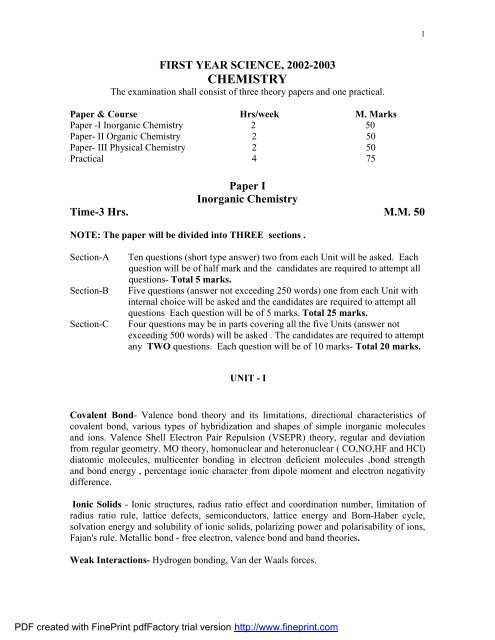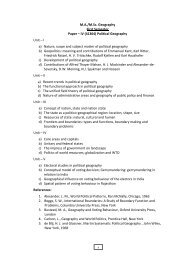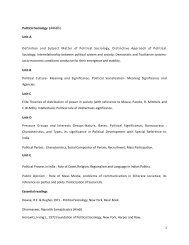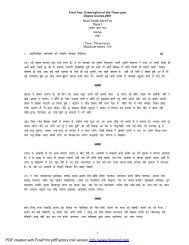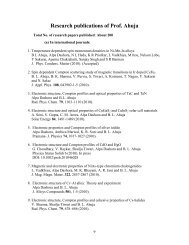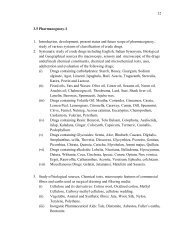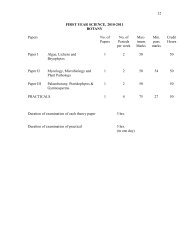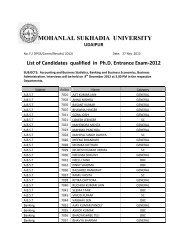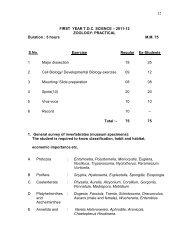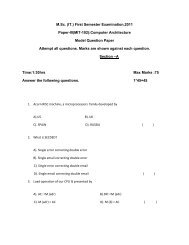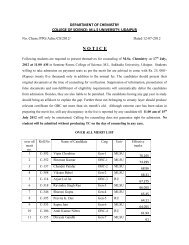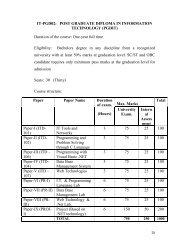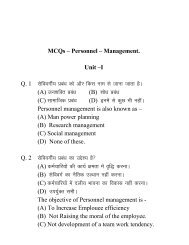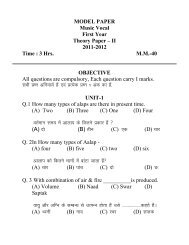Inorganic Chemistry
Inorganic Chemistry
Inorganic Chemistry
Create successful ePaper yourself
Turn your PDF publications into a flip-book with our unique Google optimized e-Paper software.
FIRST YEAR SCIENCE, 2002-2003<br />
CHEMISTRY<br />
The examination shall consist of three theory papers and one practical.<br />
Paper & Course Hrs/week M. Marks<br />
Paper -I <strong>Inorganic</strong> <strong>Chemistry</strong> 2 50<br />
Paper- II Organic <strong>Chemistry</strong> 2 50<br />
Paper- III Physical <strong>Chemistry</strong> 2 50<br />
Practical 4 75<br />
Paper I<br />
<strong>Inorganic</strong> <strong>Chemistry</strong><br />
Time-3 Hrs. M.M. 50<br />
NOTE: The paper will be divided into THREE sections .<br />
Section-A Ten questions (short type answer) two from each Unit will be asked. Each<br />
question will be of half mark and the candidates are required to attempt all<br />
questions- Total 5 marks.<br />
Section-B Five questions (answer not exceeding 250 words) one from each Unit with<br />
internal choice will be asked and the candidates are required to attempt all<br />
questions Each question will be of 5 marks. Total 25 marks.<br />
Section-C Four questions may be in parts covering all the five Units (answer not<br />
exceeding 500 words) will be asked . The candidates are required to attempt<br />
any TWO questions. Each question will be of 10 marks- Total 20 marks.<br />
UNIT - I<br />
Covalent Bond- Valence bond theory and its limitations, directional characteristics of<br />
covalent bond, various types of hybridization and shapes of simple inorganic molecules<br />
and ions. Valence Shell Electron Pair Repulsion (VSEPR) theory, regular and deviation<br />
from regular geometry. MO theory, homonuclear and heteronuclear ( CO,NO,HF and HCl)<br />
diatomic molecules, multicenter bonding in electron deficient molecules ,bond strength<br />
and bond energy , percentage ionic character from dipole moment and electron negativity<br />
difference.<br />
Ionic Solids - Ionic structures, radius ratio effect and coordination number, limitation of<br />
radius ratio rule, lattice defects, semiconductors, lattice energy and Born-Haber cycle,<br />
solvation energy and solubility of ionic solids, polarizing power and polarisability of ions,<br />
Fajan's rule. Metallic bond - free electron, valence bond and band theories.<br />
Weak Interactions- Hydrogen bonding, Van der Waals forces.<br />
PDF created with FinePrint pdfFactory trial version http://www.fineprint.com<br />
1
UNIT II<br />
s -Block Elements - Comparative study, diagonal relationships, salient features of<br />
hydrides, solvation and complexation tendencies including their function in biosystems, an<br />
introduction to metal alkyls and aryls.<br />
<strong>Chemistry</strong> of Noble Gases-History of discovery, separation of inert gases, chemical<br />
properties of the noble gases, chemistry of xenon, structure and bonding in xenon<br />
compounds.<br />
UNIT -III<br />
Group-13- General properties, oxides, hydroxide, halides and hydrides of boron, diborane<br />
and higher boranes, borohydrides, borazine, oxyacids of boron, borax and borax bead test .<br />
Group-14 - General properties, inert pair effect, halides, oxides, silicates, silicones,<br />
graphitic compounds, carbides, cyanides and carbonyls, brief idea of fullerenes.<br />
Group-15- General properties, hydrides, azides, halides, oxides and oxyacids of<br />
phosphorous, nitrogen fixation, fertilizers.<br />
UNIT - IV<br />
Group-16 - General properties, polymorphism, hydrides, halides, oxides and oxyacids of<br />
sulphur, thiosulphuric acid and salts, thionic acids and their salts, tetrasulphur tetranitride.<br />
Group-17 - General properties, hydrogen halides, oxides and oxyacids of halogens,<br />
interhalogen compounds, polyhalides, basic properties of halogens.<br />
UNIT - V<br />
Non -Aqueous Solvents - Physical properties of a solvent, types of solvents and their<br />
general characteristics, Differentiating and leveling solvents, reactions in non-aqueous<br />
solvents with special reference to liquid NH3 and liquid SO2.<br />
Acids and Bases - Arrhenius, Bronsted - Lowry, Lux - Flood, solvent system and Lewis<br />
concepts of acid and bases, Usanovitch definition.<br />
Books Recommended<br />
1. Concise <strong>Inorganic</strong> <strong>Chemistry</strong>: J. D. Lee<br />
2. General <strong>Inorganic</strong> <strong>Chemistry</strong>: J. A. Duffy, Longman (2nd Ed.)<br />
3. Principles of <strong>Inorganic</strong> <strong>Chemistry</strong>: B. R. Puri and L. R. Sharma<br />
4. Basic <strong>Inorganic</strong> <strong>Chemistry</strong>: F.A.Cotton and G. Wilkinson, Wiley Eastern<br />
5. Molecular Geometry : R. J. Gillespie, Van Nostrand Reinhold.<br />
6. <strong>Inorganic</strong> <strong>Chemistry</strong> (Hindi ed.): Suresh Ameta, A. Sharma and M. Mehta, Himanshu Pub.<br />
PDF created with FinePrint pdfFactory trial version http://www.fineprint.com<br />
2
Paper II<br />
Organic <strong>Chemistry</strong><br />
Time-3 Hrs. M.M. 50<br />
NOTE: The paper will be divided into THREE sections .<br />
Section-A Ten questions (short type answer) two from each Unit will be asked. Each<br />
question will be of half mark and the candidates are required to attempt all<br />
questions- Total 5 marks.<br />
Section-B Five questions (answer not exceeding 250 words) one from each Unit with<br />
internal choice will be asked and the candidates are required to attempt all<br />
questions Each question will be of 5 marks. Total 25 marks.<br />
Section-C Four questions may be in parts covering all the five Units (answer not<br />
exceeding 500 words) will be asked . The candidates are required to attempt<br />
any TWO questions. Each question will be of 10 marks- Total 20 marks.<br />
UNIT-I<br />
Structure and Bonding - Localized and delocalized chemical bond, Van der Waals<br />
interaction, charge transfer complexes, resonance, hyperconjugation, aromaticity,<br />
electromeric, inductive and field effects, hydrogen bonding.<br />
Mechanism of Organic Reactions - Curved arrow notation, drawing electron movements<br />
with arrows, half-headed and double- headed arrows, types of organic reactions, energy<br />
considerations.<br />
Reactive Intermediates - Carbocations, carbanions, free radicals, carbenes, arynes and<br />
nitrenes, their formation and stabilities.<br />
Methods of determination of reaction mechanism (product analysis, intermediates, isotope<br />
effects, kinetic and stereochemical studies.)<br />
UNIT-II<br />
Stereochemistry of Organic Compounds - Concept of isomerism , types of isomerism.<br />
Optical Isomerism- Elements of symmetry, molecular chirality, enantiomers, stereogenic<br />
centre, optical activity, properties of enantiomers, chiral and achiral molecules with two<br />
stereogenic centers, diastereomers, threo and erythro diastereomers, meso compounds,<br />
resolution of enantiomers, inversion, retention and racemization.<br />
Relative and absolute configuration, sequence rules, D and L & R and S systems of<br />
nomenclature.<br />
Geometric isomerism- determination of configuration of geometric isomers. E and Z<br />
systems of nomenclature, geometric isomerism in oximes and alicyclic compounds.<br />
Conformational isomerism- conformational analysis of ethane and n-butane;<br />
conformations of cyclohexane, axial and equitorial bonds, conformation of mono<br />
PDF created with FinePrint pdfFactory trial version http://www.fineprint.com<br />
3
substituted cyclohexane derivatives. Newman projection and Sawhorse formulae, Fischer<br />
and Flying Wedge formulae.<br />
Difference between configuration and conformation.<br />
UNIT-III<br />
Alkanes: General methods of formation, physical & chemical properties. Mechanism of<br />
free radical substitution in alkanes with reference to halogenation, orientation, reactivity<br />
and selectivity.<br />
Cycloalkanes - Nomenclature, methods of formation, chemical reactions, Baeyer's strain<br />
theory and its limitation, ring strain in small rings (cyclopropane and cyclobutane), theory<br />
of strainless rings, the case of cyclopropane ring : banana bond.<br />
Alkenes, Dienes and Alkynes - Brief introduction of alkenes, their formation with<br />
reference to mechanisms of dehydration of alcohols and dehydrohalogenation of alkyl<br />
halides, regioselectivity in alcohol dehydration The Saytzeff rule, Hofmann elimination,<br />
physical properties and relative stabilities of alkenes.<br />
Chemical reactions of alkenes- mechanisms involved in hydrogenation , electrophilic and<br />
free radical additions, Markownikoff's rule, hydroboration- oxidation, oxymercurationreduction,<br />
epoxidation, ozonolysis, hydration, hydroxylation and oxidation with KMnO4 ,<br />
polymerization of alkenes, substitution at the allylic and vinylic positions of alkenes,<br />
industrial applications of ethylene and propene.<br />
Nomenclature and classification of dienes: isolated, conjugated and cumulated dienes,<br />
structure of allenes and butadiene, methods of formation, polymerization, chemical<br />
reactions - 1,2 and 1,4 additions, Diels - Alder reaction.<br />
Alkynes: Acidity of alkynes, mechanism of electrophilic and nucleophilic addition<br />
reactions, hydroboration, metal - ammonia reductions, oxidation and polymerization.<br />
Unit - IV<br />
Arenes and Aromaticity - Nomenclature of benzene derivatives, the aryl group, aromatic<br />
nucleus and side chain, structure of benzene, molecular formula and Kekule structure,<br />
stability and carbon - carbon bond lengths of benzene, resonance structure and M. O.<br />
picture.<br />
Aromaticity: The Huckel rule, aromatic ions. Aromatic electrophilic substitution: General<br />
pattern of the mechanism, role of σ and π complexes. Mechanism of nitration,<br />
halogenation, sulphonation, mercuration and Friedel -Craft reaction. Energy profile<br />
diagrams. Activating and deactivating substituents, orientation and ortho-para ratio. Side<br />
chain reactions of benzene derivatives. Birch reduction, Methods of formation and<br />
chemical reactions of alkylbenzenes, alkynylbenzene and biphenyl.<br />
PDF created with FinePrint pdfFactory trial version http://www.fineprint.com<br />
4
UNIT -V<br />
Alkyl and Aryl Halides - Nomenclacture and classes of alkyl halides, methods of<br />
formation, chemical reactions, mechanism of nucleophilic substitution reactions of alkyl<br />
halides, SN 2 and SN 1 reactions with energy profile diagrams, factors affecting SN 2 and SN 1<br />
reactions.<br />
Haloform reaction, Freons:<br />
Methods of formation of aryl halides, nuclear and side chain reactions, the addition -<br />
elimination and elimination - addition reaction, mechanisms of nucleophilic aromatic<br />
substitution reactions.<br />
Relative reactivites of alkyl halides v/s allyl, vinyl and aryl halides. synthesis and uses of<br />
DDT and BHC.<br />
Books Recommended<br />
1. A Text Book of Organic <strong>Chemistry</strong>: K. S. Tiwari, S. N. Mehrotra and N. K. Vishnoi.<br />
2. Modern Principles of Organic <strong>Chemistry</strong>: M. K. Jain and S.C. Sharma<br />
3. A Text Book of Organic <strong>Chemistry</strong>: (Vol. I & II) O. P. Agarwal,<br />
4. A Text Book of Organic <strong>Chemistry</strong>: B. S. Bahl and Arun Bahl.<br />
5. A Text Book of Organic <strong>Chemistry</strong>: P. L. Soni.<br />
6. Organic <strong>Chemistry</strong>: (Vol. I, II & III) S. M. Mukherji, S. P. Singh and R.P.Kapoor, Wiley Eastern Ltd.<br />
(New Age International)<br />
7. Organic <strong>Chemistry</strong>, Morrison & Boyd, Prentice Hall.<br />
8. Organic <strong>Chemistry</strong> (Hindi Ed.):Suresh Ameta, P. B. Punjabi and B. K Sharma, Himanshu Pub<br />
PDF created with FinePrint pdfFactory trial version http://www.fineprint.com<br />
5
Paper III<br />
Physical <strong>Chemistry</strong><br />
Time-3 Hrs. M.M. 50<br />
NOTE: The paper will be divided into THREE sections .<br />
Section-A Ten questions (short type answer) two from each Unit will be asked. Each<br />
question will be of half mark and the candidates are required to attempt all<br />
questions- Total 5 marks.<br />
Section-B Five questions (answer not exceeding 250 words) one from each Unit with<br />
internal choice will be asked and the candidates are required to attempt all<br />
questions Each question will be of 5 marks. Total 25 marks.<br />
Section-C Four questions may be in parts covering all the five Units (answer not<br />
exceeding 500 words) will be asked . The candidates are required to attempt<br />
any TWO questions. Each question will be of 10 marks- Total 20 marks.<br />
UNIT - I<br />
Mathematical Concepts - Logarithmic relations, curve sketching, linear graphs and<br />
calculation of slopes, differentiation of function like kx, e x , x n , sin x, log x, maxima and<br />
minima, partial differentiation and reciprocity relations, integration of some useful/<br />
relevant functions, permutations and combinations, factorials, probability.<br />
Computers - General introduction to computers, different components of a computer,<br />
hardware and software, input-output devices, binary numbers and arithmetic, introduction<br />
to computer languages, programming operating systems.<br />
UNIT - II<br />
Gaseous State - Postulates of kinetic theory of gases, deviation from ideal behavior, Van-<br />
der Waals equation of state.<br />
Critical Phenomena - PV isotherms of real gases, continuity of states, the isotherms of Van<br />
-der Waals equation, relationship between critical constants and Van der Waals constants,<br />
the law of corresponding states, reduced equation of state.<br />
Molecular Velocities - Root mean square, average and most probable velocities, qualitative<br />
discussion of the Maxwell's distribution of molecular velocities, collision number, mean<br />
free path and collision diameter, liquefaction of gases (based on Joule - Thomson effect).<br />
Liquid State - Intermolecular forces, structure of liquid (a qualitative description).<br />
Liquid Crystals - Difference between liquid crystal, solid and liquid, classification,<br />
structure of smetic, nematic and cholestric phases, theory of liquid crystals and its<br />
applications, thermography and seven segments cell.<br />
PDF created with FinePrint pdfFactory trial version http://www.fineprint.com<br />
6
UNIT-III<br />
Solid State - Definition of space lattice, unit cell, Bravias lattices.<br />
Laws of crystallography- (i) Laws of constancy of interfacial angles (ii) Law of rationality<br />
of indices, Weiss and Miller indices (iii) Law of symmetry, symmetry elements in crystals,<br />
classification of crystals, X-ray diffraction by crystals, derivation of Bragg equation,<br />
determination of crystal structure of NaCl, KCl and CsCl (Laue's method and powder<br />
method).<br />
Colloidal State - Definition of colloids, classification of colloids.<br />
Solids in liquid (sols): Properties - kinetic, optical and electrical, stability of colloids,<br />
protective action, Hardy - Schulze law, gold number.<br />
Liquid in Liquid (emulsions): Types of emulsions, preparation, emulsifier,<br />
Liquids in solids (gels)- classification, preparation and properties, inhibition, general<br />
applications of colloids.<br />
UNIT- IV<br />
Nuclear and Radiochemistry - Elementary idea of nucleus, nuclear forces, packing<br />
fraction, mass defect and binding energy, nuclear fission and fusion reactions, calculation<br />
of Q - values of nuclear reactions, liquid drop and shell models of nucleus,<br />
theory of radioactivity, G. M. Counter, half life period, average life, radioactive<br />
disintegration, radioactive steady state, group displacement law, radioactive series,<br />
separation and identification of isotopes, application of radioactivity and radioactive<br />
tracers.<br />
UNIT-V<br />
Atomic Structure - Dual nature of electron, De Broglie equation, Davission and Germer<br />
experiment, Heisenberg uncertainty principle, Schrodinger wave equation, significance of<br />
ψ and ψ 2 , probability distribution curves, shapes of s, p and d - orbitals, Zeeman and Stark<br />
effects.<br />
Physical Properties and Molecular Structure - Physical properties of liquids, vapour<br />
pressure, measurement of vapour pressure, heat of vaporization, Trouton's rule.<br />
Surface tension, measurement of surface tension.<br />
Viscosity and its measurement, effect of temperature on the surface tension and viscosity.<br />
use of these properties in determination of chemical constitution.<br />
Books Recommended:<br />
1. Principles of Physical <strong>Chemistry</strong>: B. R. Puri and L. R. Sharma.<br />
2. A Text Book of Physical <strong>Chemistry</strong>: A. S. Negi and S. C. Anand.<br />
3. Physical <strong>Chemistry</strong>, Pt. I & II : C. .M. Gupta, J. K. Saxena and M. C. Purohit.<br />
4. Physical <strong>Chemistry</strong> (Hindi Ed.): Suresh Ameta , R.C.Khandelwal, R. Ameta and J. Vardia, Himanshu<br />
Pub.<br />
5. Computers and Applications to <strong>Chemistry</strong>, Ramesh Kumari, Narosa Publishing House Pvt. Ltd.<br />
PDF created with FinePrint pdfFactory trial version http://www.fineprint.com<br />
7
FIRST YEAR CHEMISTRY PRACTICALS,2002-2003<br />
TIME: 5 Hrs.( one day) M.M. 75<br />
Distribution of Marks Marks<br />
Exercises-<br />
1. Semi-micro Analysis of <strong>Inorganic</strong> mixture containing five radicals 20<br />
(excluding Na + and K + ).<br />
2. (i)Detection of extra elements (N, S, and halogen) if any 10<br />
and functional groups in given simple organic compounds.<br />
(ii)Purification of the given organic compounds by crystallisation 10<br />
(charcoal) sublimation and determination of its m.p. .<br />
or<br />
Determination of mixed melting points using urea- cinnamic acid mixtures<br />
of given compositions.<br />
3. ONE physical <strong>Chemistry</strong> experiment 15<br />
4. Viva- Voce 10<br />
5. Records 10<br />
Total 75 Marks<br />
List of Experiments:<br />
1. Semi micro Analysis of <strong>Inorganic</strong> mixture: The mixture shall contain Five radicals<br />
( at least two cations & two anions) soluble in water or in HCl. Two cations of the same<br />
group except II A & II B may be given. Not more than one interfering radical may be<br />
given. Interfering radical may not be given with typical anion combinations.<br />
2. (i) Detection of extra elements (N,S, and halogen) if any and functional group in<br />
given simple organic compounds.( one organic compound from the following list<br />
be given for identification ).<br />
Carboxylic acids, Phenols, Alcohols, Carbohydrates, Aldehydes, Ketones, Nitro<br />
Compounds, Amino compounds, Anilides, Amides, Esters, Thioamide,<br />
Hydrocarbons, Halogen containing compounds<br />
(ii) Crystallization:<br />
Concept of induction of crystallization<br />
Phthalic acid from hot water (using fluted filter paper and stemless funnel)<br />
Acetanilide from boiling water<br />
Naphthalene from ethanol<br />
Benzoic acid from water<br />
PDF created with FinePrint pdfFactory trial version http://www.fineprint.com<br />
8
Decolourisation and crystallization using charcoal<br />
Crystallization and decolourisation of impure naphthalene (100 g of naphthalene<br />
mixed with 0.3 of Congo Red using 1 g decolourising carbon) from ethanol.<br />
Simple Sublimation : Camphor, Naphthalene, Phthalic acid and Succinic acid.<br />
Mixed Melting Point determination<br />
Urea- Cinnamic acid mixture of various compositions(1:4, 1:1, 4:1)<br />
3. Physical <strong>Chemistry</strong> Experiments- Any one of the following experiments may be given<br />
in the examination.<br />
.<br />
Distribution Law:<br />
(i). To study the distribution of iodine between water and CCl4.<br />
(ii). To study the distribution of benzoic acid between benzene and water.<br />
(iii)To study the distribution of acetic acid between benzene and water<br />
Colloids:<br />
To prepare arsenious sulphide sol and compare the precipitating power of mono-,bi-<br />
and trivalent anions.<br />
Viscosity and Surface Tension:<br />
(i) To determine the percentage composition of a given mixture(non interacting<br />
systems) by viscosity method.<br />
(ii) To determine the percentage composition of a given binary mixture by surface tension<br />
method<br />
(iii) To determine the parachor value of – CH2 – group.<br />
(iv) To determine the rheochor value of – CH2 – group.<br />
Transition Temperature<br />
(i) Determination of the transition temperature of the given substance by thermometric/<br />
dialometric method ( e.g.: MnCl2. 4H2O, SrBr2 . 2H2O)<br />
Thermochemistry:<br />
(i) To determine the solubility of benzoic acid at different temperatures and to determine<br />
ΔH of the dissolution process<br />
(ii) To determine the enthalpy of neutralisation of a weak acid/ weak base versus strong<br />
base/ strong acid and determine the enthalpy of ionisation of the weak acid/weak<br />
base<br />
(iii) To determine the enthalpy of solution of solid calcium chloride and calculate the<br />
lattice energy of calcium chloride from its enthalpy data using Born- Haber cycle.<br />
PDF created with FinePrint pdfFactory trial version http://www.fineprint.com<br />
9
Books Recommended:<br />
1. Practical chemistry - Giri, Bajpai and Pandey. S. Chand & Co. Ltd. New Delhi<br />
2. Laboratory Manuel in Organic <strong>Chemistry</strong>, R.K. Bansal, Willey Eastern<br />
3. Experimental Organic <strong>Chemistry</strong> Vol.I & II, P.R. Singh, D.S. Gupta & K.S. Bajpai, Tata Mc Graw Hill.<br />
4. Experiments in Physical <strong>Chemistry</strong>- J.C. Ghose, Bherti Bhawan<br />
5. Experiments in General <strong>Chemistry</strong> N.R. rao & U.C. Agarwal, Eastern Press<br />
6. Practical <strong>Chemistry</strong>- Suresh Ameta & P.B. Punjabi, Himanshu Publication.<br />
PDF created with FinePrint pdfFactory trial version http://www.fineprint.com<br />
10
SECOND YEAR SCIENCE, 2003-2004<br />
CHEMISTRY<br />
The examination shall consist of three theory papers and one practical.<br />
Paper & Course Hrs/week M. Marks<br />
Paper -I <strong>Inorganic</strong> <strong>Chemistry</strong> 2 50<br />
Paper- II Organic <strong>Chemistry</strong> 2 50<br />
Paper- III Physical <strong>Chemistry</strong> 2 50<br />
Practical 4 75<br />
PAPER-I<br />
<strong>Inorganic</strong> <strong>Chemistry</strong><br />
Time-3 Hrs. M.M. 50<br />
NOTE: The paper will be divided into THREE sections .<br />
Section-A Ten questions (short type answer) two from each Unit will be asked. Each<br />
question will be of half mark and the candidates are required to attempt all<br />
questions- Total 5 marks.<br />
Section-B Five questions (answer not exceeding 250 words) one from each Unit with<br />
internal choice will be asked and the candidates are required to attempt all<br />
questions Each question will be of 5 marks. Total 25 marks.<br />
Section-C Four questions may be in parts covering all the five Units (answer not<br />
exceeding 500 words) will be asked . The candidates are required to attempt<br />
any TWO questions. Each question will be of 10 marks- Total 20 marks.<br />
UNIT- I<br />
<strong>Chemistry</strong> of Elements of First Transition Series - Characteristic properties of d-block<br />
elements (colour, variable valency, magnetic and catalytic properties and ability to form<br />
complexes). Properties of the elements of the first transition series, their binary compounds<br />
and complexes illustrating relative stability of their oxidation states, coordination number<br />
and geometry.<br />
<strong>Chemistry</strong> of Elements of Second and Third Transition Series - General characteristics,<br />
comparative treatment with their 3d-analogues in respect of ionic radii, oxidation states,<br />
magnetic behavior, spectral properties and stereochemistry.<br />
PDF created with FinePrint pdfFactory trial version http://www.fineprint.com<br />
11
UNIT II<br />
Oxidation and Reduction - Use of redox potential data, analysis of redox cycle, redox<br />
stability in water - Frost, Latimer and Pourbaix diagrams, principles involved in the<br />
extraction of the elements.<br />
Coordination Compounds - Werner's coordination theory and its experimental<br />
verification, effective atomic number concept, nomenclature of coordination compounds,<br />
isomerism in coordination compounds, valence bond theory of transition metal complexes,<br />
chelate and chelate effects.<br />
UNIT- III<br />
<strong>Chemistry</strong> of Lanthanides - Electronic structure, oxidation states and ionic radii,<br />
lanthanide contraction, complex formation, occurrence and isolation, lanthanide<br />
compounds.<br />
<strong>Chemistry</strong> of Actinides - General feature and chemistry of actinides, chemistry of<br />
separation of Np, Pu and Am from U, similarities between the later actinides and the later<br />
lanthanides<br />
UNIT- IV<br />
Gravimetric Analysis- Principles, solubility, formation and preparation of precipitation,<br />
colloidal properties, ageing and contamination of the precipitates, co-precipitation and<br />
post-precipitation.<br />
Simple Organic Reagents used in Organic Analysis - 8-Hydroxyquinoline,<br />
Dimethylglyoxime, α-nitroso-β-naphthol, Anthranilic acid, Arsonic acids, Cupron and<br />
Cupferron.<br />
UNIT- V<br />
Chromatography - Basic principles, instrumentation and application of adsorption, and<br />
partition chromatography, ion exchange separation.<br />
Error in Quantitative Analysis - Accuracy and Precision, determinate, indeterminate and<br />
accidental errors, precision of a single measurement, precision of mean, rejection of a<br />
result, errors in a derived result, methods of checking the accuracy of analysis, significant<br />
figures, computation values.<br />
Book Recommended:<br />
1. Text Book of Quantitative <strong>Inorganic</strong> Analysis: A. I. Vogel (Chapter- I, II and XXIII).<br />
2. Text Book of Quantitative <strong>Inorganic</strong> Analysis: I. M. Kothoff and E. R. Sandell.<br />
3. Concise <strong>Inorganic</strong> <strong>Chemistry</strong>: J. D. Lee.<br />
4. General <strong>Inorganic</strong> <strong>Chemistry</strong>: J. A. Duffy.<br />
5. Principle of <strong>Inorganic</strong> <strong>Chemistry</strong>: B. R. Puri and L. R. Sharma.<br />
6. Basic <strong>Inorganic</strong> <strong>Chemistry</strong>: Cotton and Wilkinson and Gaus, Willey.<br />
7. <strong>Inorganic</strong> <strong>Chemistry</strong> (Hindi ed.): Suresh Ameta, A. Sharma and M. Mehta<br />
PDF created with FinePrint pdfFactory trial version http://www.fineprint.com<br />
12
PAPER II<br />
ORGANIC CHEMISTRY<br />
Time-3 Hrs. M.M. 50<br />
NOTE: The paper will be divided into THREE sections .<br />
Section-A Ten questions (short type answer) two from each Unit will be asked. Each<br />
question will be of half mark and the candidates are required to attempt all<br />
questions- Total 5 marks.<br />
Section-B Five questions (answer not exceeding 250 words) one from each Unit with<br />
internal choice will be asked and the candidates are required to attempt all<br />
questions Each question will be of 5 marks. Total 25 marks.<br />
Section-C Four questions may be in parts covering all the five Units (answer not<br />
exceeding 500 words) will be asked . The candidates are required to attempt<br />
any TWO questions. Each question will be of 10 marks- Total 20 marks.<br />
Unit-I<br />
Alcohols and Epoxides<br />
Unsaturated alcohols- Vinyl and Allyl alcohol<br />
Dihydric alcohol - Nomenclature, method of formation and chemical reactions of vicinal<br />
glycols.<br />
Pinacol- Pinacolone rearrangement.<br />
Trihydric alcohols - Formation and chemical reactions of glycerol.<br />
Epoxides - Synthesis and reactions of epoxides, orientation of epoxide ring opening.<br />
Phenols – Nomenclature, structure and bonding, preparation of phenols, physical<br />
properties and acidic character, comparative acidic strength of alcohols and phenols,<br />
resonance stablization of phenoxide ion.<br />
Reactions of phenols - Electrophilic aromatic substitution, acylation and carboxylation,<br />
Mechanism of Fries rearrangement, Clasien rearrangement, Gatterman synthesis, Hauben-<br />
Hoesch reaction, Lederer-Manasse reaction and Reimer-Tiemann reaction.<br />
Unit II<br />
Aldehydes and Ketones - Synthesis, chemical and physical properties of aromatic<br />
aldehydes and ketones, mechanism of nucleophilic addition to carbonyl group with<br />
particular emphasis on Benzoin, Aldol, Perkin and Knoevenagel condensations,<br />
condensation with ammonia and its derivatives, Wittig reaction, Mannich reaction.<br />
Use of acetals as protecting group. Oxidation of aldehydes , Baeyer- Villiger oxidation of<br />
ketones, Cannizzaro reaction, MPV, Clemmenson, Wolff-Kishner, LiAlH4 and NaBH4<br />
reductions, Halogenation of enolizable ketones.<br />
An introduction to α,β - unsaturated aldehydes and ketones.<br />
PDF created with FinePrint pdfFactory trial version http://www.fineprint.com<br />
13
Unit III<br />
Carboxylic Acids and their derivatives - Nomenclature, structure and bonding, acidity of<br />
carboxylic acids, effects of substituents on acid strength, mechanism of decarboxylation,<br />
Method of formation, physical properties and chemical reactions of dicarboxylic acids -<br />
oxalic, succinic and phthalic acid.<br />
Substituted Acids – Methods of formation & chemical reactions of halo acids, hydroxy<br />
acids, malic, tartaric, citric and salicyclic acids.<br />
Unsaturated Acids - Acrylic and cinnamic acid.<br />
Introduction to acids derivatives - Prepartion, properties and uses of acid, halides, amides,<br />
anhydrides and ethers. Interconversion of acid derivatives by nucleophilic acyl<br />
substitution. Mechanism of HVZ reaction, Hofmann - bromamide reaction and ester<br />
hydrolysis.<br />
UNIT - IV<br />
Organic compounds of Nitrogen: - Preparation & chemical reactions of nitroazenes.<br />
Reactivity of nitro substituted anenes.<br />
Aromatic amines Classification, preparation, properties and uses of primary amino<br />
compounds -aniline, acetanilide, nitroaniline.<br />
Secondary amino compounds- diphenylamine and N-methyl aniline<br />
Tertiary amino compounds- Triphenylamine and N,N-dimethyl aniline<br />
Aryl alkyl amine- Benzyl amine<br />
Basic strength of amines- similarities and differences between aliphatic and aromatic<br />
amines.<br />
Diazonium salt- formation , properties and synthetic uses of benzene diazonium salts,<br />
Diazo coupling & its mechanism.<br />
Organic Sulphur Compounds: Preparation and properties of thiols, sulphonic acid,<br />
sulphonyl chloride, saccharides, chloramine - T, dichloramine-T and sulphonamides.<br />
UNIT V<br />
Polynuclear Hydrocarbons - Nomenclature of naphthalene and anthracene derivatives,<br />
preparation and properties of naphthalene, anthracene, naphthol, naphthylamine,<br />
naphthaquinone and anthraquinone.<br />
Mechanism and orientation of electrophilic substitution reaction in naphthalene and<br />
anthracene.<br />
Organometallic Compounds - Preparation, properties and synthetic uses of organo<br />
lithium and organo zinc compounds.<br />
PDF created with FinePrint pdfFactory trial version http://www.fineprint.com<br />
14
Books Recommended<br />
1. A Text Book of Organic <strong>Chemistry</strong>: K. S. Tiwari, S. N. Mehrotra and N. K. Vishnoi.<br />
2. Modern Principles of Organic <strong>Chemistry</strong>: M. K. Jain & S. C. Sharma<br />
3. A Text Book of Organic <strong>Chemistry</strong>: (Vol. I & II) O. P. Agarwal,<br />
4. A Text Book of Organic <strong>Chemistry</strong>: B. S. Bahal and Arun Bahal.<br />
5. A Text Book of Organic <strong>Chemistry</strong>: P. L. Soni.<br />
6. Organic <strong>Chemistry</strong>: (Vol. I, II & III) S. M. Mukherji, S. P. Singh and R.P. Kapoor.<br />
7. Organic <strong>Chemistry</strong> (Hindi Ed.):Suresh Ameta, P. B. Punjabi and B. K Sharma, Himanshu Pub.<br />
PDF created with FinePrint pdfFactory trial version http://www.fineprint.com<br />
15
Paper-III<br />
PHYSICAL CHEMISTRY<br />
Time-3 Hrs. M.M. 50<br />
NOTE: The paper will be divided into THREE sections .<br />
Section-A Ten questions (short type answer) two from each Unit will be asked. Each<br />
question will be of half mark and the candidates are required to attempt all<br />
questions- Total 5 marks.<br />
Section-B Five questions (answer not exceeding 250 words) one from each Unit with<br />
internal choice will be asked and the candidates are required to attempt all<br />
questions Each question will be of 5 marks. Total 25 marks.<br />
Section-C Four questions may be in parts covering all the five Units (answer not<br />
exceeding 500 words) will be asked . The candidates are required to attempt<br />
any TWO questions. Each question will be of 10 marks- Total 20 marks.<br />
UNIT I<br />
Thermodynamics – I: Definition of thermodynamic terms, system, surrounding, etc., types<br />
of systems, intensive and extensive properties, state and path functions, their differentials,<br />
thermodynamics process, concept of heat and work.<br />
First law of Thermodynamics - Statement, definition of internal energy and enthalpy, heat<br />
capacity, heat capacities at constant volume and pressure and their relationship, Joule' s<br />
law, Joule-Thomson coefficient and inversion temperature, calculation of w, q, dU and dH<br />
for the expansion of ideal gases under isothermal and adiabatic conditions for reversible<br />
process.<br />
Thermochemistry: Standard state, standard enthalpy of formation, Hess's law of heat<br />
summation and its applications, Heat of reaction at constant pressure and at constant<br />
volume, Enthalpy of neutralization, bond dissociation energy and its calculation from<br />
thermochemical data, temperature dependence of enthalpy, Kirchhoff' s equation.<br />
UNIT-II<br />
Thermodynamics - II : Second law of thermodynamics: need for the law, different<br />
statements of the law, Carnot cycle and its efficiency, Carnot theory, thermodynamic scale<br />
of temperature.<br />
Concept of entropy: Entropy as a state function, entropy as a function of V and T, entropy<br />
as a function of P and T, entropy change in physical change, Clausius inequality, entropy<br />
as a criteria of spontaneity and equilibrium, entropy change in ideal gases and mixing of<br />
gases.<br />
Third Law of Thermodynamics - Nernst heat theorem, statement and concept of residual<br />
entropy, evaluation of absolute entropy from heat capacity data. Gibbs and Helmholtz<br />
PDF created with FinePrint pdfFactory trial version http://www.fineprint.com<br />
16
function, Gibbs function (G) and Helmholtz function (A) as thermodynamic quantities, A<br />
& G as criteria for thermodynamic equilibrium and spontaneity, their advantage over<br />
entropy change, variation of G and A with P, V and T.<br />
Chemical Equilibrium - Equilibrium constant and free energy, thermodynamic derivation<br />
of law of mass action, distribution law and phase rule, Le Chatelier's principle, Nernst's<br />
distribution law for solute, principle of extraction of solute from solution and washing of<br />
precipitates.<br />
Reaction isotherm and reaction isochore - Clapeyron equation and Clausius - Clapeyron<br />
equation, applications, partial molar quantities, partial molar volume and its distribution,<br />
chemical potential and its physical significance, Gibbs-Duhem equation.<br />
UNIT-III<br />
Macromolecules - Nomenclature, classification, properties of polymer, mass of<br />
macromolecules, number average and weight average molecular mass, determination of<br />
molecular weight by osmotic pressure, viscosity and light scattering and sedimentation<br />
(ultra centrifuge) methods.<br />
Surface <strong>Chemistry</strong> - Sorption at surfaces, physical and chemical adsorption, Freundlich,<br />
Langmuir and Gibbs adsorption isotherms and their derivation, Streaming potential<br />
electrophoresis and electrosmosis.<br />
UNIT-IV<br />
Phase Equilibrium - Statement and meaning of the terms - phase, component and degree<br />
of freedom, derivation of Gibb's phase rule, phase equilibrium of one component system-<br />
water, CO2 and S - system.<br />
Phase equilibria of two component system - Solid - liquid equilibria, simple eutectic, Bi-<br />
Cd, Pb-Ag systems, desilverization of lead.<br />
Solid solutions - Compound formation with congruent melting point (Mg - Zn) and<br />
incongruent melting point, (NaCl - H2O), (FeCl3 - H2O) and (CuSO4 - H2O) systems,<br />
freezing mixtures, acetone - dry ice.<br />
Liquid - liquid mixtures: Ideal liquid mixtures, Raoult's and Henry's law, Non -ideal<br />
system, azeotropes: HCl - H2O and ethanol - water systems.<br />
Partially miscible liquids: phenol - water, trimethylamine - water, nicotine - water systems,<br />
lower and upper consolute temperature, effect of impurity on consulate temperature.<br />
Immiscible liquids, steam distillation.<br />
UNIT V<br />
Electrochemistry : Types of reverse electrode : gas - metal ion, metal-metal ion, metalinsoluble<br />
salt - anion and redox electrodes, electrode reactions, Nernst equation, derivation<br />
of cell E.M.F. and single electrode potential, standard hydrogen electrode-reference<br />
electrodes-standard electrode potential, sign conventions, electrochemical series and its<br />
significance, electrolytic and Galvanic cells- reversible and irreversible cells, conventional<br />
PDF created with FinePrint pdfFactory trial version http://www.fineprint.com<br />
17
epresentation of electrochemical cells. EMF of a cell and its measurements, computation<br />
of cells EMF. Calculation of thermodynamic quantities of cell reactions (ΔG, ΔH and K)<br />
polarization, over potential and hydrogen over voltage. Concentration cell with or without<br />
transport, liquid junction potential, application of concentration cells, valency of ions,<br />
solubility product and activity coefficient, potentiometric titrations.<br />
Ionic Equilibria - Arrhenius theory of electrolyte and its application, Ostwald's dilution<br />
law, its uses and limitations. Debye - Huckle theory of strong electrolytes, asymmetric<br />
electrophoretic, Debye- Falkenhagen and Wein effects, Activity coefficient, mean activity<br />
coefficient, ionic strength, Debye- Huckel limiting law.<br />
Book Recommended:<br />
1. Principle of Physical chemistry: B. R. Puri Sharma and M. S. Pathania,<br />
2. A Text Book of Physical <strong>Chemistry</strong>: A. S. Negi and S.C. Anand.<br />
3. A Text Book of Physical <strong>Chemistry</strong>: Kundu and Jain.<br />
4. Physical <strong>Chemistry</strong> (Hindi Ed.): Suresh Ameta , R.C.Khandelwal, R. Ameta and J. Vardia.<br />
PDF created with FinePrint pdfFactory trial version http://www.fineprint.com<br />
18
SECOND YEAR CHEMISTRY PRACTICALS, 2003-2004<br />
Distribution of Marks<br />
Time 5 Hrs.( one day) M.M. 75<br />
Marks<br />
Exercises-<br />
1. Volumetric estimation 20<br />
or<br />
Gravimetric analysis<br />
2. Determination of Rf values and identification of given 10<br />
organic compounds using thin layer / paper chromatography.<br />
3. Identification of given organic compound through functional group<br />
analysis 10<br />
4. Physical chemistry Experiments 15<br />
5. Viva - Voice 10<br />
6. Record 10<br />
Total 75 Marks<br />
List of Experiments<br />
(1) Volumetric Analysis: ( Any one of the following exercise may be given in the<br />
examination.<br />
(a) Determination of acetic acid in commercial vinegar using NaOH<br />
(b) Determination of alkali content- antacid tablet using HCl.<br />
(c) Estimation of calcium content in chalk as calcium oxalate using permanganate.<br />
(d) Estimation of hardness of water by EDTA.<br />
(e) Estimation of ferrous and ferric ions by dichromate methods.<br />
(f) Estimation of copper using thiosulphate.<br />
(g) Estimation of Mg 2+ , Ca 2+ or Ba 2+ complexometrically.<br />
OR<br />
Gravimetric Analysis :<br />
Analysis of Cu as CuSCN and Ni as Ni (dimethylgloxime)<br />
PDF created with FinePrint pdfFactory trial version http://www.fineprint.com<br />
19
Note: Candidates are required to prepare standard solutions by proper weighing.<br />
2. Thin Layer Chromatography :<br />
Determination of Rf values and identification of organic compounds.<br />
(a) Separation of green leaf pigments (spinach leaves may be used)<br />
(b) Preparation and separation of 2,4-dinitrophenylhydrazones of acetone, 2-<br />
butanone, hexane-2-and 3-one using toluene and light petroleum(40:60)<br />
(c) Separation of a mixture of dyes using cyclohexane and ethyl acetate (8.5:1.5)<br />
Paper Chromatography:<br />
Determination of Rf values and identification of organic compounds in a mixture of<br />
amino acids / monosaccharides.<br />
3. Identification of Organic Compounds:<br />
An organic compound from the following list be given for systematic identification:<br />
(i) Formic, Acetic, Propanoic and Butanoic acids.<br />
(ii) Phenols- Phenol, Resorcinol, Hydroquinone, p-Cresol, α- Naphthol,β-Naphthol.<br />
(iii) Alcohols- Methyl, Ethyl, Propyl,Isopropyl, n- butyl, isobutyl and tert. butyl alcohol.<br />
(iv) Carboxylic acids- Oxalic, Tartaric, Citric, Succinic, Benzoic, Cinnamic, Salicylic,<br />
Phthalic acids<br />
(v) Carbohydrates- Glucose, Fructose, Cane sugar and Starch.<br />
(vi) Aldehydes- Formaldehyde, Acetaldehyde and Benzaldenyde.<br />
(vii) Ketones- Acetone, Methyl ethyl ketone, Acetophenone and Benzophenone.<br />
(viii) Nitro compounds - Nitrobenzene, p- Nitrotoluene and m- Dinitrobenzene.<br />
(ix) Amino compounds - Aniline, o-, m-and p-toluidine, ∝- Naphthylamine and<br />
β-Naphthylamine.<br />
(x) Anilides - Acetanilide and Benzanilide.<br />
(xi) Amides - Acetamide, Benzamide and Urea.<br />
(xii) Esters - Methyl acetate, Ethyl acetate.<br />
(xiii)Thioamide - Thiourea.<br />
(xiv) Hydrocarbons - Benzene, Toluene, Naphthalene and Anthracene.<br />
(xv) Halogen containing compounds - Chloroform, Chloral hydrate, Iodoform,<br />
Chlorobenzene, p- D ichlorobenzene and p- Dibromobenzene.<br />
4. Physical chemistry experiments- Any one of the following experiments may be given<br />
in the examination.<br />
Chemical Kinetics:<br />
(i). To determine the specific reaction rate of the hydrolysis of methyl acetate/ ethyl<br />
acetate catalyzed by hydrogen ions at room temperature.<br />
(ii). To study the effect of acid strength on the hydrolysis of an ester.<br />
(iii) To study kinetically the reaction rate of decomposition of iodide by peroxydisulphate.<br />
(iv) To study the hydrolysis of an ester in presence of a base.<br />
(iv) To determine the relative strength of two acids using ester hydrolysis.<br />
PDF created with FinePrint pdfFactory trial version http://www.fineprint.com<br />
20
Phase Equilibrium<br />
(i)To study the effect of a solute (e. g. NaCl, succinic acid) on the critical solution<br />
temperature of two partially miscible liquids (e.g. Phenol-water system) and to<br />
determine the concentration of that solute in the given phenol-water system.<br />
(ii)To construct the phase diagram of two component (e. g. diphenylamine- benzophenone)<br />
system by cooling curve method.<br />
Adsorption:<br />
(i) To study the adsorption of acetic acid by activated charcoal and test the validity<br />
of Freundlich or Langmuir adsorption isotherm.<br />
(ii) To study the adsorption of oxalic acid by activated charcoal and test the validity<br />
of Freundlich or Langmuir adsorption isotherm.<br />
Books Recommended:<br />
1 Practical chemistry - Giri, Bajpai and Pandey. S. Chand & Co. Ltd. New Delhi<br />
2 Laboratory Manuel in Organic <strong>Chemistry</strong>, R.K. Bansal, Wiley Eastern<br />
3 Experimental Organic <strong>Chemistry</strong> Vol.I & II, P.R. Singh, D.S. Gupta & K.S. Bajpai, Tata Mc Graw Hill.<br />
4 Experiments in Physical <strong>Chemistry</strong>- J.C. Ghose, Bherti Bhawan<br />
5 Experiments in General <strong>Chemistry</strong> N.R. rao & U.C. Agarwal, Eastern Press<br />
6 Practical <strong>Chemistry</strong>- Suresh Ameta & P.B. Punjabi, Himanshu Publication.<br />
PDF created with FinePrint pdfFactory trial version http://www.fineprint.com<br />
21
THIRD YEAR SCIENCE, 2004-2005<br />
CHEMISTRY<br />
The examination shall consist of three theory papers and one practical.<br />
Paper & Course Hrs/week M. Marks<br />
Paper -I <strong>Inorganic</strong> <strong>Chemistry</strong> 2 50<br />
Paper- II Organic <strong>Chemistry</strong> 2 50<br />
Paper- III Physical <strong>Chemistry</strong> 2 50<br />
Practicals 4 75<br />
PAPER-I<br />
<strong>Inorganic</strong> <strong>Chemistry</strong><br />
Time-3 Hrs. M.M. 50<br />
NOTE: The paper will be divided into THREE sections .<br />
Section-A Ten questions (short type answer) two from each Unit will be asked. Each<br />
question will be of half mark and the candidates are required to attempt all<br />
questions- Total 5 marks.<br />
Section-B Five questions (answer not exceeding 250 words) one from each Unit with<br />
internal choice will be asked and the candidates are required to attempt all<br />
questions Each question will be of 5 marks. Total 25 marks.<br />
Section-C Four questions may be in parts covering all the five Units (answer not<br />
exceeding 500 words) will be asked . The candidates are required to attempt<br />
any TWO questions. Each question will be of 10 marks- Total 20 marks.<br />
UNIT- I<br />
Hard and Soft Acids and Bases (HSAB) - Classification of acids and bases as hard and<br />
soft. Pearson's HSAB concept, acid-base strength and hardness and softness. Symbiosis,<br />
theoretical basis of hardness and softness, electronegativity and hardness and softness.<br />
Metal-Ligand Bonding in Transition Metal Complexes - Limitation of valence bond<br />
theory, an elementary idea of crystal field theory, crystal field splitting in octahedral,<br />
tetrahedral and square planar complexes, factors affecting the crystal- field parameters,<br />
John- Teller effect.<br />
UNIT- II<br />
Magnetic Properties of Transition Metal Complex - Types of magnetic behaviour,<br />
methods of determining magnetic susceptibility, spin-only formula. L-S coupling,<br />
correlation of μs and μeff values, orbital contribution to magnetic moments, application of<br />
magnetic moment data for 3d- metal complexes.<br />
PDF created with FinePrint pdfFactory trial version http://www.fineprint.com<br />
22
Electronic Spectra of Transition Metal Complexes - Types of electronic transitions,<br />
selection rule for d-d transitions, spectroscopic ground states, spectrochemical series.<br />
Orgel-energy level diagram for d 1 and d 9 states, discussion of the electronic spectrum of<br />
[Ti(H2O)6] 3+ complex ion.<br />
UNIT- III<br />
Bioinorganic <strong>Chemistry</strong> - Essential and trace elements in biological processes,<br />
metalloporphyrins with special reference to haemoglobin and myoglobin. Biological role<br />
of alkali and alkaline earth metal ions with special reference to Ca 2+ .<br />
Electroanalytical Methods - EMF measurements, pH - determination using hydrogen,<br />
glass, quinhydrone, antimony and calomel electrodes, potentiometric titrations.<br />
Volumetric Estimation - Theory of oxidation - reduction titrations. Theory of<br />
complexometric titrations.<br />
UNIT- IV<br />
Organometallic <strong>Chemistry</strong> - Definition, nomenclature and classification of<br />
organometallic compounds. Preparation, properties, bonding and applications of alkyl and<br />
aryl of Li, Al, Hg, Sn and Ti, a brief account of metal - ethylenic complexes and<br />
homogeneous hydrogenation, mononuclear carbonyls and the nature of bonding in metal<br />
carbonyls.<br />
Thermodynamic and Kinetic Aspects of Metal Complexes - A brief outline of<br />
thermodynamic stability of metal complexes and factors affecting the stability, substitution<br />
reactions of square planar complexes.<br />
UNIT- V<br />
Molecular Symmetry and Group Theory - Symmetry elements, molecular point groups,<br />
group theory and basic properties, similarity transformation and classes, orthogonality<br />
theorem, multiplication tables and characters tables of C2V and C3V groups.<br />
Mathematical Techniques - Least square treatment applied to linear equation y = mx + c,<br />
correlation coefficient, σm and σC .<br />
Books Recommended:<br />
1. Group theory and its chemical applications: P. K. Bhattacharya.<br />
2. <strong>Inorganic</strong> chemistry: J. E. Huyee, (Principles of structure & Reactivity, 3rd Ed.)<br />
3. Selected topics in inorganic chemistry: W. U. Malik, G. D. Tuli and R. madan.<br />
4. Principles of inorganic chemistry: D. Banerjie.<br />
5. Modern aspect of inorganic chemistry: H. J. Emeleus and A. G. Sharpe.<br />
6. <strong>Inorganic</strong> chemistry (Hindi Ed.): Ameta, Sharma and Mehta.<br />
PDF created with FinePrint pdfFactory trial version http://www.fineprint.com<br />
23
PAPER-II<br />
Organic <strong>Chemistry</strong><br />
Time-3 Hrs. M.M. 50<br />
NOTE: The paper will be divided into THREE sections .<br />
Section-A Ten questions (short type answer) two from each Unit will be asked. Each<br />
question will be of half mark and the candidates are required to attempt all<br />
questions- Total 5 marks.<br />
Section-B Five questions (answer not exceeding 250 words) one from each Unit with<br />
internal choice will be asked and the candidates are required to attempt all<br />
questions Each question will be of 5 marks. Total 25 marks.<br />
Section-C Four questions may be in parts covering all the five Units (answer not<br />
exceeding 500 words) will be asked . The candidates are required to attempt<br />
any TWO questions. Each question will be of 10 marks- Total 20 marks.<br />
UNIT-I<br />
Electromagnetic Spectrum: Absorption Spectra – Ultraviolet (UV) absorption<br />
spectroscopy- absorption laws ( Beer-Lambert law), molar absorptivity, presentation and<br />
analysis of UV spectra, types of electronic transition, effect of conjugation. Concept of<br />
chromophore and auxochrome. Bathochromic, hypsochromic, hyperchromic and<br />
hypochromic shifts. UV spectra of conjugated enes and enones.<br />
Intrared (IR) absorption spectroscopy- molecular vibrations, Hooke’s, selection rules,<br />
intensity and position of IR bands, measurement of IR spectrum, fingerprint region,<br />
characteristic absorptions of various functional groups and interpretation of IR spectra of<br />
simple organic compounds.<br />
Nuclear Magnetic Resonance (NMR) spectroscopy: Proton Magnetic Resonance (PMR)<br />
spectroscopy, nuclear shielding and desheilding, chemical shift and molecular structure,<br />
spin- spin splitting and coupling constants, areas of signals, interpretation of PMR spectra<br />
of simple organic molecules such as ethyl bromide, ethanol, acetaldehyde, 1,1,2tribromoethane,<br />
ethyl acetate, toluene and acetophenone.<br />
Problem pertaining to the structure elucidation of simple organic compounds using UV, IR<br />
and PMR spectroscopic techniques.<br />
PDF created with FinePrint pdfFactory trial version http://www.fineprint.com<br />
24
UNIT-II<br />
Heterocyclic compounds - Introduction molecular orbital picture and aromatic<br />
characteristics of pyrrole, furane, thiophene and pyridine, method of synthesis and<br />
chemical reactions with particular emphasis on the mechanism of electrophilic substitution.<br />
Mechanism of nucleophilic substitution reactions in pyridine derivatives, comparision of<br />
basicity of pyridine, piperidine and pyrrole.<br />
Introdution to condensed five and six membered heterocycles, preparation and reactions of<br />
indole, quinoline and isoquinoline with speacial reference to Fischer Indole synthesis,<br />
Skraup's synthesis and Bischler - Napieralski synthesis. Mechanism of electrophilic<br />
substituion reactions of indole, quinoline and isoquinoline.<br />
Photochemistry: Principles: electronic excitation, excited states, modes of dissipation of<br />
energy , energy transfer and quantum efficiency, photoreduction and photochemistry of<br />
butadienes<br />
UNIT - III<br />
Organic synthesis via Enolates - Acidity of alpha hydrogen, alkylation of<br />
diethylmalonate and ethylacetoacetate, synthesis of ethyl acetoacetate, Claisen<br />
condensation. Keto - Enol tautomerism of ethyl acetoacetate, alkylation of 1,3- dithianes,<br />
alkylation and acylation of enamines.<br />
Carbohydrates - Classification and nomenclature, monossacharides, mechanism of<br />
osazone formation, interconversion of glucose and fructose, chain lengthening and chain<br />
shortening of aldoses, configuration of glucose and fructose, erythreo and threo<br />
diastereomers. Conversion of glucose into mannose, formation of glycosides, ether and<br />
esters. Determination of ring size of glucose and fructose, Cyclic structure of D (+) -<br />
glucose. Mechanism of mutarotation.<br />
An introduction to disaccharide (maltose, sucrose and lactose) and polysaccharides (starch<br />
and cellulose) without involving structure determination.<br />
UNIT - IV<br />
Amino Acids, Peptides, proteins and Nucleic Acids - Classification, structure and<br />
stereochemistry of amino acids, acid-base behavior, isoelectric point and electrophoresis.<br />
Preparation and reactions of α- amino acids.<br />
Structure and nomenclacture of peptides and protiens, classification of proteins, peptide<br />
structure determination, and group analysis, selective hydrolysis of peptides. Classical<br />
peptide synthesis, solid-phase peptide synthesis. Structures of peptide and proteins. Levels<br />
of protein structure. Protein denaturation/renaturation.<br />
Nucleic acids: Introduction, constituents of nucleic acids. Ribonucleosides and<br />
ribonucleotides. The double helical structure of DNA.<br />
PDF created with FinePrint pdfFactory trial version http://www.fineprint.com<br />
25
Fats, Oils and Detergents - Natural Fats, edible and industrial oils of vegetable origin,<br />
common fatty acids, glycerides, hydrogenation of unsaturated oils, saponification value,<br />
iodine value, acid value, soaps, synthetic detergents, alkyl and aryl sulphonates.<br />
UNIT-V<br />
Synthetic Polymers - Addition or chain - growth polymerization, free radical vinyl<br />
polymerization, ionic - vinyl polymerization, Ziegler-Natta polymerization and vinyl<br />
polymers. Condensation or step-growth polymerization, polyesters, polyamides, phenol<br />
formaldehyde resins, urea formaldehyde resins, epoxy resins and polyurethanes, natural<br />
and synthetic rubbers.<br />
Synthetic Dyes - Colour and constitution (electronic concept), classification of dyes.<br />
<strong>Chemistry</strong> and synthesis of methyl orange, Congo red, Malachite green, Crystsal violet,<br />
Phenophthalein, Fluorescein, Alizarin and Indigo.<br />
Books Recommended:<br />
1. Organic chemistry, Volume I and II S. M. Mukherji. S. P. Singh and R. P. Kapoor, Wiley Eastern Ltd.<br />
2 A Text Book, of Organic chemistry, Volume I & II K. S. Tewari, S. N. Mehrortra & N. K. Vishnoi. .<br />
3. Organic chemistry, M. K. Jain and S. Sharma<br />
4 A Text Book. of Organic <strong>Chemistry</strong>, Vol. I & II (iii) O. P. Agarwal,<br />
5. A Text Book of Organic <strong>Chemistry</strong>, Raj. K. Bansal.<br />
6. Organic <strong>Chemistry</strong>. Vol. I & II: I. L. Finar,<br />
7. Organic Reaction and their Mechanisms, P. S. Kalsi.<br />
8. Introduction of Petrochemicals, Sukumar Maiti,<br />
9. Organic <strong>Chemistry</strong> (Hindi Ed.), Suresh Ameta, Punjabi and Sharma.<br />
10. Organic <strong>Chemistry</strong>, Morrson and Boyd, Prentice-Hall<br />
11. Fundamentals of Organic <strong>Chemistry</strong>, Solomons, John Wiley.<br />
12. Organic <strong>Chemistry</strong>, P.L. Soni<br />
13 A Text Book of Organic <strong>Chemistry</strong>, V.K. Ahluwalia and Maduri Goyal, Narosa Publshing House<br />
Pvt. Ltd.<br />
PDF created with FinePrint pdfFactory trial version http://www.fineprint.com<br />
26
PAPER-III<br />
Physical <strong>Chemistry</strong><br />
Time-3 Hrs. M.M. 50<br />
NOTE: The paper will be divided into THREE sections .<br />
Section-A Ten questions (short type answer) two from each Unit will be asked. Each<br />
question will be of half mark and the candidates are required to attempt all<br />
questions- Total 5 marks.<br />
Section-B Five questions (answer not exceeding 250 words) one from each Unit with<br />
internal choice will be asked and the candidates are required to attempt all<br />
questions Each question will be of 5 marks. Total 25 marks.<br />
Section-C Four questions may be in parts covering all the five Units (answer not<br />
exceeding 500 words) will be asked . The candidates are required to attempt<br />
any TWO questions. Each question will be of 10 marks- Total 20 marks.<br />
UNIT-I<br />
Elementary Quantum Mechanics - Black-body radiation, Planck's radiation law,<br />
photoelectric effect, heat capacity of solids, Bohr's model of hydrogen atom (no derivation)<br />
and its defects, Compton effect.<br />
Sinusodial wave equation, Hamiltonian operator, Schrodinger wave equation and its<br />
importance, physical interpretation of the wave function, postulates of quantum mechanics,<br />
particle in one-dimensional box.<br />
Schrodinger wave equation for H-atom, separation into three equations (without<br />
derivation), quantum numbers and their importance, hydrogen like wave functions, radial<br />
wave functions, angular wave function.<br />
Molecular orbital theory, basic ideas- criteria for forming M. O. from A. O., construction<br />
of M. O's by LCAO- H2 + ion, calculation of energy levels from wave functions, physical<br />
picture of bonding and antibonding wave functions, concept of σ, σ*, π, π* orbitals and<br />
their characteristics. Hybrid orbitals- sp, sp 2 , sp 3 , calculation of coefficients of A.O's used<br />
in these hybrid orbitals.<br />
Introduction to valence bond model of H2, M. O. and V. B. models.<br />
PDF created with FinePrint pdfFactory trial version http://www.fineprint.com<br />
27
UNIT-II<br />
Spectroscopy - Introduction: electromagnetic radiation, regions of the spectrum, basic<br />
features of different spectrometers, statement of the Born- Oppenheimer approximation,<br />
degrees of freedom.<br />
Rotational Spectrum - Diatomic molecules, energy levels of a rigid rotator (semi-<br />
classical principles), selection rules, spectral intensity, distribution using population<br />
distribution (Maxwell - Boltzmann distribution) determination of bond length, qualitative<br />
description of non-rigid rotor, isotope effect.<br />
Vibrational Spectrum - Infrared spectrum, energy level of simple harmonic oscillator,<br />
selection rules, pure vibrational spectrum, intensity, determination of force constant and<br />
qualitative relation of force constant and bond energies, effect of anharmonic motion and<br />
isotope on the spectrum, idea of vibrational frequencies of different functional groups.<br />
Raman spectrum: Concept of polarizability, pure rotational and pure vibrational Raman<br />
spectra of diatomic molecules, selection rules.<br />
Electronic Spectrum - Concept of potential energy curves for bonding and antibonding<br />
molecular orbitals, qualitative description of selection rules and Franck-Condon principle.<br />
Qualitative description of σ, π and n M.O., their energy levels and the respective<br />
transitions.<br />
UNIT-III<br />
Photochemistry - Interaction of radiation with matter, difference between thermal and<br />
photochemical processes, laws of photochemistry, Grothus - Drapper law, Stark - Einstein<br />
law, Jablonski diagrame depicting various processes occuring in the excited state,<br />
qualitative description of fluorescence, phosphorescence, non-radiative process (internal<br />
conversion, intersystem crossing), high and low quantum yields, photosensitization,<br />
photochemical equilibrium, photoionization, photodimerisation of anthracene,<br />
photoinhibition, chemical actinometry.<br />
Solutions, Dilute Solutions and Colligative Properties - Ideal and non-ideal solutions,<br />
methods of expressing concentrations of solutions, activity and activity coefficient.<br />
Dilute solution: colligative properties, Raoult's law, relative lowering of vapour pressure,<br />
molecular weight determination. Osmosis, law of osmotic pressure and its<br />
measurement,<br />
Determination of molecular weight from osmotic pressure, elevation of boiling point and<br />
depression of freezing point, thermodynamic derivation of relation between molecular<br />
weight and elevation in boiling point and depression in freezing point, experimental<br />
PDF created with FinePrint pdfFactory trial version http://www.fineprint.com<br />
28
methods for determining various colligative properties, abnormal molar mass, degree of<br />
dissociation and association of solute, Vant-Hoff factor.<br />
UNIT-IV<br />
Ionic Conductance - Electrical transport, conduction in metal and electrolytes, solutions,<br />
specific conductance, equivalent conductance and molecular conductance, effect of<br />
dilution on conductance, migration of ions, Kohlraush's law and its applications, transport<br />
numbers and its determination by Hittorf's method and moving boundry methods, ionic<br />
mobility, application of conductivity measurement, conductometric titrations.<br />
UNIT-V<br />
Chemical Kinetics and Catalysis - Rate of reaction, factors influencing the rate of<br />
reaction, concentration, temperature, pressure, solvent, light and catalysis, order of a<br />
reaction, zero-order, first order and second order reaction, half life and mean life,<br />
conductometric, potentiometric, polarimeteric and spectrophotometric methods of<br />
determination of order of reactions, method of integration, half life method and isolation<br />
method, experimental methods of kinetics, elementary idea about opposing, parallel,<br />
consecutive and chain reaction, effect of temperature on reaction rates. Arrhenius equation,<br />
concept of activation energy and its measurement, simple collision's theory (hard sphere<br />
model), transition state theory (equilibrium hypothesis) limitation's.<br />
Theory of unimolecular reactions, catalysis, theory and mechanism, classification of<br />
catalysis, enzyme catalysis and its mechanism.<br />
1. Principle of Physical chemistry: B. R. Puri Sharma and M. S. Pathania,<br />
2. A Text Book of Physical <strong>Chemistry</strong>: A. S. Negi and S.C. Anand.<br />
3. A text Book of Physical <strong>Chemistry</strong>: Kundu and Jain.<br />
4. Physical <strong>Chemistry</strong> (Hindi Ed.): Suresh Ameta , Khandelwal, Ameta and Vardia.<br />
PDF created with FinePrint pdfFactory trial version http://www.fineprint.com<br />
29
THIRD YEAR CHEMISTRY PRACTICALS, 2004-2005<br />
TIME - 5 Hrs (one day) M.M. 75<br />
Distribution of Marks<br />
Experiments: Marks<br />
1. Synthesis of <strong>Inorganic</strong> complex and organic compound. 15<br />
2. Analysis by Colorimetry/ Solvent extraction/ Ion exchange method 10<br />
3. Qualitative analysis: Organic mixture analysis 15<br />
4. One Physical experiment 15<br />
5. Viva- Voce 10<br />
6. Record 10<br />
Total 75 Marks<br />
List of experiments<br />
1. Synthesis of <strong>Inorganic</strong> complexes and organic compounds<br />
Any one of the following preparation may be asked in the examination keeping in view<br />
that not more than five students are given the same preparation in a batch of 20<br />
students and nature of preparation should be equally distributed both from the organic<br />
and inorganic list.<br />
<strong>Inorganic</strong> Complexes<br />
(a) Preparation of sodium trisoxalato ferrate (III)<br />
(b) Preparation of Ni-DMG complex..<br />
(c) Preparation of copper tetraammine complex.<br />
(d) Preparation of cis- and trans- bisoxalato diaquo chromate(III) ion.<br />
(e) Cuprous chloride<br />
(f) Sodium thiosulphate<br />
(g) Ferrous sulphate from Kipp's waste<br />
(h) Mercury tetrathiocyanate<br />
PDF created with FinePrint pdfFactory trial version http://www.fineprint.com<br />
30
Organic Synthesis<br />
(a) Acetylation of salicylic acid, aniline, glucose and hydroquinone, benzoylation of<br />
aniline and phenol.<br />
(b) Aliphatic electrophilic substitution –<br />
Preparation of iodoform from ethanol and acetone.<br />
(c) Aromatic electrophilic substution -<br />
Nitration -<br />
Preparation of m-dinitrobenzene from nitrobenzene.<br />
Preparation of p-nitroacetanilide from acetanilide<br />
Halogenation-<br />
Preparation of p-bromoacetanilide from acetanilide.<br />
Preparation of 2,4,6-tribromophenol from phenol.<br />
(d) Diazotization/coupling -<br />
Preparation of methyl orange and methyl red<br />
(e) Oxidation-<br />
Preparation of benzoic acid from toluene<br />
(f) Reduction-<br />
Preparation of aniline from nitrobenzene.<br />
Preparation of m-nitroaniline from m-dinitrobenzene<br />
2 (i) Analysis by Colorimetry-<br />
(a) Job's method (b) Mole- ratio method<br />
Adulteration - Food stuffs.<br />
Effluent analysis, water analysis.<br />
(ii) Solvent Extraction - Separation and estimation of Mg (II) and Fe (II).<br />
(iii) Ion Exchange - Separation and estimation of Mg (II) and Zn (II).<br />
3. Qualitative Analysis -<br />
Analysis of an organic mixture containing two solid components separable by water,<br />
dil. NaHCO3 and dil. NaOH.<br />
4. Physical <strong>Chemistry</strong> experiment - Any one of the experiments may be given in the<br />
examination.<br />
PDF created with FinePrint pdfFactory trial version http://www.fineprint.com<br />
31
Conductometry-<br />
(i) To determine the strength of the given acid conductometrically using standard alkali<br />
solution.<br />
(ii) To determine the solubility and solubility products of a sparingly soluble electrolyte<br />
conductometrically.<br />
(iii) To study the saponification of ethyl acetate conductometrically.<br />
(iv) To determine the ionization constant of a weak acid conductometrically.<br />
Potentiometry-<br />
(i) To titrate potentiometrically the given ferrous ammonium sulphate solution using<br />
KMnO4 / K2Cr2O7 as titrate and calculate the redox potential of Fe 2+ / Fe 3+ system<br />
on the hydrogen scale.<br />
(ii) To determine the strength of a given solution of HCl/ CH3COOH by titrating with<br />
standard NaOH solution potentiometrically/ pH metrically.<br />
Refractometry, Polarimetry-<br />
(i) To verify law of refraction of mixtures (e.g. of glycerol and water) using Abbe's<br />
refractometer.<br />
(ii)To determine the specific rotation of a given optically active compounds.<br />
Colourimetry-<br />
(i) To verify Beer - Lambert law for KMnO4 / K2Cr2O7 and determine the concentration<br />
of the given solution of the substances.<br />
(ii) Estimation of iron colorimetrically.<br />
(iii) Estimation of phosphate colorimetrically.<br />
Books Recommended:<br />
1 Practical chemistry - Giri, Bajpai and Pandey. S. Chand & Co. Ltd. New Delhi<br />
2 Laboratory Manuel in Organic <strong>Chemistry</strong>, R.K. Bansal, Willey Eastern<br />
3 Experimental Organic <strong>Chemistry</strong> Vol.I & II, P.R. Singh, D.S. Gupta & K.S. Bajpai, Tata Mc Gram Hill.<br />
4 Experiments in Physical <strong>Chemistry</strong>- J.C. Ghose, Bherti Bhawan<br />
5 Experiments in General <strong>Chemistry</strong> N.R. rao & U.C. Agarwal, Eastern Press<br />
6 Practical <strong>Chemistry</strong>- Suresh Ameta & P.B. Punjabi, Himanshu Publication.<br />
PDF created with FinePrint pdfFactory trial version http://www.fineprint.com<br />
32


